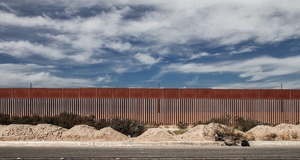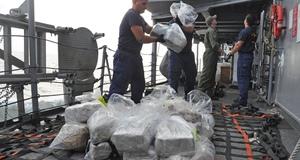Featured Article:Mexican Drug Activity, Economic Development, and Unemployment in a Rational Choice Framework
By
2013, Vol. 5 No. 09 | pg. 4/4 | « The relationship between GDP per capita and drug arrests in Ciudad Juarez and Nogales is more complex and not as easily understood. As opposed to GDP per capita and homicides, there does not appear to be an obvious third variable influence that could affect the strength of the relationship between the input and outcome variables. A cursory glance at the data sets reveal a relatively steady increase in GDP per capita in the sampled cities, while drug arrests seemed to vary on an annual basis. There are two issues that are readily apparent; first and foremost, the regression analysis was limited to drug arrest data available from 2000 to 2008. Given the lack of available data, it is unknown how President Calderon’s policies may have affected drug arrest statistics in the years after he surged Mexican security forces into areas controlled by the cartels. In addition, 2008 drug arrest data for Ciudad Juarez represents somewhat of an outlier; as cited by the INEGI, only partial data was available for that year. An updated regression analysis excluding 2008 data reveals an Adjusted R Square of -.057with a P-Value well outside of the confidence interval. By eliminating the outlier, the relationship has become statistically insignificant. While the act of eliminating outliers may explain the unusual relationship between GDP per capita and drug arrests in Ciudad Juarez, Nogales still possesses a moderate correlation even after excluding 2008 data. Despite the moderate statistical relationship, it is possible that the correlation has been established purely by chance. As the GDP of Nogales has increased in lockstep with the Mexican economy, so have the number of annual drug arrests within the city. While both variables seem to increase incrementally over the course of the observation period, correlation does not necessarily translate to causality. The increase in drug arrests is consistent with President Calderon’s pre-2010 “Law and Order” policy that advocated increased drug enforcement activities in Northern Mexico. In a controversial reversal of existing Mexican national security policy, Calderon embraced aspects of the multilateral Merida Initiative that were outright rejected by his predecessors. In addition to increased training and logistical assistance from the United States, the Administration placed an increased emphasis on extraditing cartel “kingpins” and disrupting the existing supply chain. As a result, both the United States and Mexico heralded a large number of arrests for illicit transportation, production and distribution activities beginning in 2006. Scherlen (2012) noted an increase in annual drug arrests in Northern Mexican cities until 2010, when internal and external pressure forced Calderon to soften his position in favor of a demand-side solution to the drug problem (Scherlen, 2012). While it is entirely possible that some sort of correlation exists between GDP per capita and drug arrests, available empirical evidence is lacking and it is likely that domestic enforcement policies directly contributed to the increased arrests. The same can be said about the moderate to strong correlation between unemployment rates, homicides and drug arrests in Ciudad Juarez and Nuevo Laredo. On the surface, some of the data seems to affirm H2, which predicted a positive relationship between unemployment rates, homicides and drug arrests. Consistent with the unemployment rates of other industrialized countries that were affected by the global economic recession, Ciudad Juarez and Nuevo Laredo saw a gradual increase in their respective jobless rates beginning in 2008. As most of Mexico experienced a period of economic decline, President Calderon implemented his aggressive anti-drug policy, which resulted in increased arrests and homicides in select areas controlled by the cartels. While any relationship between unemployment, drug arrests and homicides appears coincidental, further research will need to be conducted to study the effects of Mexican drug policy on arrest rates and homicides in Mexican border cities that form the drug corridor. Due to the political sensitivities surrounding the drug war, the Mexican government has released very little information about security operations in Northern Mexico. Groups like the Transborder Institute based out of the University of San Diego have begun to track drug arrests and drug-related violence through media outlets and open source materials. However, most of these nongovernmental organizations have only recently begun to standardize their data collection methods and the statistics required to initiate a time series study is not currently available.On the US side of the border, the only statistically significant relationship identified was a moderate positive correlation between GDP per capita and drug arrests in Phoenix. Again, a review of scholarly literature does not point to a strong positive association between GDP per capita and drug arrests (or many other criminal offenses for that matter). Though this correlation does seem to counter H2, it is likely that the relationship was affected by a third variable akin to correlation identified in Nogales. After almost fifteen years of steady growth, a quarterly economic review issued by the University of Arizona reported a massive contraction of the state’s economy beginning in the summer of 2008. Vest (2008) stated that as a percent representation of the aggregate national GDP per capita, Arizona’s major municipal centers slipped from 85% to 78% of the national average as the recession began to affect commerce, home sales, and employment. By 2010, that percentage decreased again, but stabilized at 77% (Vest, 2010). As the recession began affecting the GDP per capita of major cities in Arizona, Phoenix reported the lowest crime rates since 2004. From homicides and violent crime to drug arrests, the Phoenix Police Department credited “hot spotting” and other intelligence-oriented policing strategies for disrupting criminal networks and focusing resources on crime prone areas (Collom & Newton, 2008). Again, while it is possible that there is a connection between GDP per capita and drug arrests, the likelihood is that the association identified in this study is spurious. Summary, Conclusions, and RecommendationsWhile a relationship between municipal economic indicators, homicides and drug arrests could not be determined from this study, Sutherland’s Rational Choice Theory was not disproved either. The Mexican drug war is a complex multi-dimensional issue influenced by a number of different sociocultural factors. While economic disparity is an important part of the conflict, the confluence of many internal and external political, social, and historical issues make this matter a particularly difficult one to solve. Though a relationship between the two phenomena could not be established, what this study did do well is highlight some of the limitations regarding the use of official sources of data. Due to the size and scope of Mexico’s informal economy, official unemployment statistics and GDP per capita did not accurately represent the urban economy of the sampled cities in Northern Mexico. As an alternative to using unemployment and GDP data, Burdett et al. (2004) suggested comparing the percent of the population eligible for government benefits, like social security. This method would be especially effective in Mexico, where only those who participate in the formal economy and are eligible for government benefits are counted in the official unemployment rate. Even more important is the number of individuals not eligible for government benefits, which could provide a clearer picture of the exact size of the informal economy in each city. Municipal homicide totals and drug arrests were greatly affected by the policies and actions of the Calderon Administration as he pursued the Big Four cartels in Northern Mexico. Given the degree to which government policy impacted both homicides and drug arrests, an alternative source of information is needed in order to determine if the Rational Choice Model had any impact on the surge of drug activity. While Acharya alluded to this method in her case study of Nuevo Leon, a better approach to gathering information about the participatory behaviors of city dwellers in drug-related activities could be a qualitative survey. The survey could address recent and past involvement in all aspects of drug activity, ranging from production to sales and distribution. In addition, a survey could give the researcher an opportunity to specifically address whether adverse economic conditions ever prompted the participant to consider or actually engage in activities that support drug trafficking organizations. While there are obvious technical issues regarding the cost of producing the survey, identifying a sample population, and actually administering the survey, this method has the potential of yielding valuable data in support of the Rational Choice Theory. Further, it could provide social scientists and policymakers insight into why otherwise productive members of society would actively support organized crime groups. As a policy matter, the issue of drug violence along the US-Mexico Border is very important. Aside from the obvious human toll exacted by the drug war, the United States and various nongovernmental organizations have contributed billions of dollars with the hope of revitalizing different sectors of the Mexican economy. The US Agency for International Development alone contributed over $400 million for development projects in different parts of Mexico in 2011. That does not include the $20 billion of private remittances granted by US-based companies and NGO’s annually (US Overseas Loans and Grants, 2013). If the Merida Initiative is the proverbially “stick” being utilized to train Mexico’s military to fight the drug cartels on their own turf, aid packages and remittances represent the expensive “carrot” that will hopefully employ those who would turn to the DTO’s for work. While this sounds like an effective strategy, what if the findings produced by this study are accurate and there is absolutely no correlation between economic conditions and drug activity? The billions of dollars invested in the Mexican economy with the hope of putting people to work and depriving traffickers of a willing workforce will have been squandered. While time and resources have been invested in controlling the production and distribution of narcotics, additional funds could have been set aside for potential solutions that address the demand for illicit substances. More importantly, during a time of domestic economic hardship, would not that money have been better spent on economic initiatives that put Americans to work? While this study does not provide these answers, it does reaffirm the need to study a problem prior to contributing precious resources. ReferencesAcharya, A.K. (2011). Urban Violence in Northern Border of Mexico: A Study from Nuevo Leon State. Sociology Mind, 1 (4). 177-182. Arsovska, J. & Kostakos, P.A. (2008). Illicit arms trafficking and the limits of rational choice theory: the case of the Balkans. Trends in Organized Crime, 11 (4). 352-378. Baron, S.W. (2007). Street Youth, Gender, Financial Strain, and Crime: Exploring Broidy and Agnew’s Extension to General Strain Theory. Deviant Behavior, 28(1): 273-302. Burdett, K., Lagos, R., & Wright, R. (2004). An On-the-Job Search Model of Crime, Inequality and Unemployment. International Economic Review, 45(3): 681-706. Bureau of Labor Statistics (2013). Labor Force Statistics from the Current Population Survey. Retrieved from http://www.bls.gov/cps/lfcharacteristics.htm#unemp. Collom, L. & Newton, C. (2008). Crime falls in Phoenix; police credit new tactics. The Arizona Republic. Retrieved from http://www.azcentral.com/news/articles/0229phxcrime 0229.html?&wired. Fox, S. & Hoelscher, K. (2010). The Political Economy of Violence: Theory and Evidence from a Cross-Country Study. Crisis States Working Papers, 72(2). London, UK: LSE DESTIN. Gould, E.D., Weinberg, B.A., & Mustard, D.A. (2002). Crime Rates and Local LaborOpportunities in the United States: 1979-1997. The Review of Economics and Statistics, 84(1): 45-61. Killebrew, R. (2011). Criminal Insurgency in the Americas and Beyond. PRISM Security Studies Journal, 2 (3): 33-52. Knickerbocker, B. (2006). Illegal Immigrants in the US: How many are there? The Christian Science Monitor. Retrieved from http://www.csmonitor.com /2006/0516/p01s02-ussc.html. Lacey, M. (2009). In Mexico, Ambivalence on a Law. The New York Times. Retrieved from http://www.nytimes.com/2009/08/24/world/americas/24mexico.html? pagewanted=all. Manwaring, M.G. (2007). A Contemporary Challenge to State Sovereignty: Gangs and other Illicit Transnational Criminal Organizations in Central America, El Salvador, Mexico, Jamaica and Brazil. Security Studies Institute of the US Army War College. Washington, DC: US Government Printing Office. Martin, G. (2000). Employment and Unemployment in Mexico in the 1990’s. Monthly Labor Review, 123 (11): 3-18. Phillips, J. & Land, K.C. (2012). The link between unemployment and crime rate fluctuations: An analysis at the county, state, and national levels. Social Science Research, 41(1): 681-694. Raphael, S. & Winter-Ebmer, R. (2001). Identifying the Effect of Unemployment on Crime. U. of Chicago Journal of Law and Economics, 44: 259-281. Scherlen, R.G. (2012). US Evaluation of Mexican Drug War Efforts: Short-Termed and Short-Sighted. The Latin Americanist, 56(2). 35-61. Scherlen, R.G. (2009). The Colombianization of Mexico? The Evolving Mexican Drug War (1st ed.). New Orleans: Southern Political Science Association. Seper, J. (2011, April 20). Los Zetas Spread Message of Fear; Violent Mexican Drug Cartel Establishing Footholds in the U.S. The Washington Times. Page A01. Shirk, D.A. (2010). Drug Violence in Mexico: Data and Analysis from 2001-2009. Trends in Organized Crime, 13: 167-174. Truman, E.M. (1996). The Mexican Peso Crisis: Implications for International Finance. Federal Reserve Bulletin. Retrieved from http://www.federalreserve.gov /pubs/bulletin/1996/396lead.pdf. US Overseas Loans & Grants (2013). United States Agency for International Development. Retrieved from http://gbk.eads.usaidallnet.gov/. United States Joint Forces Command (2008). The Joint Operating Environment 2008. Washington, DC: Government Print Office. Vest, M.J. (2010). The recovery is stronger than appreciated. Arizona’s Economy. Retrieved from http://azeconomy.eller.arizona.edu/azeconomyissues/AEFall10.pdf. Vest, M.J. (2008). Still looking for the bottom. Arizona’s Economy. Retrieved from http://azeconomy.eller.arizona.edu/azeconomyissues/AEFall08.pdf. Villarreal, M.A. (2010). NAFTA and the Mexican Economy (CRS Report #7-5700). Retrieved from http://www.fas.org/sgp/crs/row/RL34733.pdf. Widner, B., Reyes-Loya, M.L. & Enomoto, C.E. (2011). Crimes and Violence in Mexico: Evidence from Panel Data. The Social Science Journal, 48: 604-611. Wilkinson, T. (2009). Mexico drug traffickers corrupt politics. LA Times. Retrieved from http://www.latimes.com/news/nationworld/world/la-fg-michoacan-drugs31-2009may31,0,3065365,full.story. Wright, R.F. (2010). Mexican Drug Violence and Adversarial Experiments. North Carolina Journal of International Law and Commercial Regulation, 35(2): 363-385. AppendixTable 5: Arrests for drug-related offenses by municipality in Mexico from 2000 – 2010.
Statistics gathered from the Instituto Nacional de Estadística y Geografía (INEGI) at www.inegi.org.mx. Per the INEGI, drug arrests are listed under the blanket arrest “en material de narcoticos,” which includes a large number of different drugs offenses, including but not limited to illicit drug consumption, possession with intent to distribute narcotics, and drug smuggling activities. * = Statistics unavailable for the listed year. Table 6: Municipal homicides of sampled Mexican cities from 2000 – 2010.
Municipal statistics gathered from the Instituto Nacional de Estadística y Geografía (INEGI) at www.inegi.org.mx. State-level statistics were gathered from the Transborder Institute at http://justiceinmexico.org/data-portal/2480-2/. For the missing years, a percent representation was derived by dividing the municipal homicides by state level homicides. The percentages were averaged together to calculate an average percent representation. The average percent was multiplied by state level statistics for the years where data is unavailable to generate a predictive statistic. * = Homicide statistics were unavailable for the listed year. Formula Table 7: Gross Domestic Product (GDP) per capita of sampled Mexican cities from 2000 – 2010.
Statistics gathered from the Instituto Nacional de Estadística y Geografía (INEGI) at www.inegi.org.mx. GDP is measured in Mexican pesos. * = Based on partial-year data; *** = Data unavailable for that year. Table 8: Unemployment rates of sampled Mexican cities from 2000 – 2010.
Statistics gathered from the Instituto Nacional de Estadística y Geografía (INEGI) at www.inegi.org.mx. This data represents the statistical average over a twelve month reporting period. Table 9: Annual drug arrest totals of sampled US cities from 2000 – 2010.
Data obtained from the Bureau of Justice Statistics. Statistics gathered through the Arrest Analysis Tool found at http://bjs.ojp.usdoj.gov/index.cfm?ty=datool&surl=/arrests/index.cfm#. This data represents total arrest tallies recorded by major municipal police departments in each city. Statistics are voluntarily provided by each department annually. The statistics have been subdivided into two categories: arrests for the sale or manufacturing of illicit substances and arrests for the possession substances for personal use. Drug violation totals in each of the four cities have been captured. * = Denotes a lack of available statistics in that given year. Table 10: Municipal homicides of sampled US cities from 2000 – 2010.
Data obtained from the Federal Bureau of Investigation, Uniform Crime Report. Statistics gathered through the UCR Table Building tool found at http://www.ucrdatatool.gov/. This data represents homicide totals recorded by major municipal police departments in each city. Statistics are voluntarily provided by each department annually. * = Individual homicide statistics are collected and distributed to the FBI by the El Paso County Sheriff's Department and the El Paso City Police Department. Statistics are listed separately (SD for Sheriff's Department and PD for the City Police Department) and together (SD and PD added to represent the total number of homicides). Table 11: Gross Domestic Product (GDP) per capita of sampled US cities from 2000 – 2010.
Data obtained from the US Department of Commerce, Bureau of Economic Analysis. Statistics gathered through the BEA's Interactive Data Service tool at http://www.bea.gov/itable/. This data represents the statistical average over a twelve month reporting period. GDP is measured in US dollars. Table 12: Unemployment rates of sampled US cities from 2000 – 2010.
Data obtained from the US Department of Labor, Bureau of Labor Statistics. Statistics gathered through the BLS Tools application at http://data.bls.gov/cgi-bin/surveymost?la. This data represents the statistical average over a twelve month reporting period. Suggested Reading from Inquiries Journal
Inquiries Journal provides undergraduate and graduate students around the world a platform for the wide dissemination of academic work over a range of core disciplines. Representing the work of students from hundreds of institutions around the globe, Inquiries Journal's large database of academic articles is completely free. Learn more | Blog | Submit Latest in Criminology & Criminal Justice | |||||||||||||||||||||||||||||||||||||||||||||||||||||||||||||||||||||||||||||||||||||||||||||||||||||||||||||||||||||||||||||||||||||||||||||||||||||||||||||||||||||||||||||||||||||||||||||||||||||||||||||||||||||||||||||||||||||||||||||||||||||||||||||||||||||||||||||||||||||||||||||||||||||||||||||||||||||||||||||||||||||||||||||||||||||||||||||||||||||||||||||||||||||||||||||||||||||||||||||||||||||||||||||||||||||||||||||||||||||||||||||||||||||||||||||||||||||||||||||||||||||||||||||||||||||||||||||||||||||||||||||||||||||||||||||||||||||||||||||||||||||||||||||||||||||||||||||||||||||||||||||||||||||||||||||||||||||||||||||||||||||||||||||||||||||||||||||||||||||||||||||||||||||||||||||||||||||||||||||||||||||


















